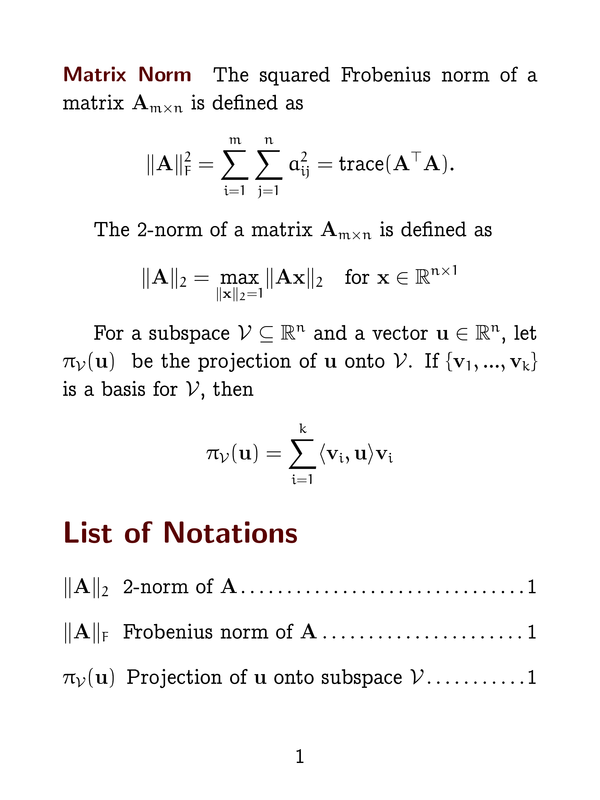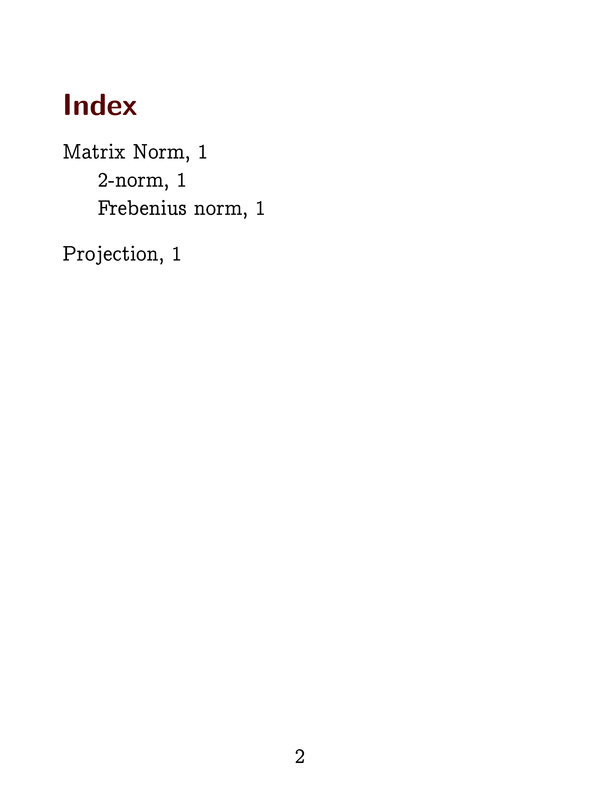April 17, 2010
This document is generated as follows.
[ytyoun@Ordnung:~/doQment/]# xelatex test[ytyoun@Ordnung:~/doQment/]# makeindex test[ytyoun@Ordnung:~/doQment/]# makeindex test.nlo -s nomencl.ist -o test.nls[ytyoun@Ordnung:~/doQment/]# xelatex test |
1 2 3 4 5 6 7 8 9 10 11 12 13 14 15 16 17 18 19 20 21 22 23 24 25 26 27 28 29 30 31 32 33 34 35 36 37 38 39 40 41 42 43 44 45 46 47 48 49 50 51 52 53 54 55 56 57 58 59 60 61 62 63 64 65 66 67 68 69 70 71 72 73 74 | \documentclass[12pt]{article} \usepackage{hyperref}\usepackage[papersize={120mm, 160mm}, text={95mm, 130mm}]{geometry} % fancy fonts\usepackage{concrete} % for fancy section font and color\usepackage{color}\definecolor{section_color}{rgb}{0.35,0.0,0}\usepackage{sectsty}\allsectionsfont{\color{section_color}\sffamily\selectfont} % fancy math\usepackage{amsmath,amssymb} % mathematical shorthand\newcommand{\Abf}{\ensuremath{\mathbf{A}}}\newcommand{\ubf}{\ensuremath{\mathbf{u}}}\newcommand{\vbf}{\ensuremath{\mathbf{v}}}\newcommand{\xbf}{\ensuremath{\mathbf{x}}}\newcommand{\Vcal}{\ensuremath{\mathcal{V}}}\newcommand{\Rbb}{\ensuremath{\mathbb{R}}} \newcommand{\norm}[1]{\ensuremath{\lVert{#1}\rVert}}\newcommand{\proj}[2]{\ensuremath{\pi_{#1}(#2)}}\newcommand{\trans}[1]{\ensuremath{{#1}^\top}}\newcommand{\bkt}[1]{\ensuremath{\langle{#1}\rangle}} % math operators\DeclareMathOperator{\trace}{trace} % index generation\usepackage{makeidx}\makeindex % 'list of notations' generation\usepackage[refpage]{nomencl} % refer to the page where notation appears\renewcommand{\nomname}{List of Notations}\renewcommand*{\pagedeclaration}[1]{\unskip\dotfill\hyperpage{#1}}\makenomenclature \begin{document}\paragraph{Matrix Norm}\index{Matrix Norm}The squared \index{Matrix Norm!Frebenius norm}Frobenius norm of a matrix$\Abf_{m\times n}$ is defined as\nomenclature{$\norm{\Abf}_F$}{Frobenius norm of $\Abf$}\begin{equation*} \norm{\Abf}_F^2 = \sum_{i=1}^m\sum_{j=1}^na_{ij}^2 = \trace(\trans\Abf\Abf).\end{equation*} The 2-norm\index{Matrix Norm!2-norm} of a matrix $\Abf_{m\times n}$ isdefined as\nomenclature{$\norm{\Abf}_2$}{2-norm of $\Abf$}\begin{equation*}\norm{\Abf}_2 = \max_{\norm{\xbf}_2=1}\norm{\Abf\xbf}_2\quad\text{for $\xbf\in\Rbb^{n\times 1}$}\end{equation*} For a subspace $\Vcal\subseteq \Rbb^n$ and a vector $\ubf\in\Rbb^n$,let $\proj{\Vcal}{\ubf}$\nomenclature{$\proj{\Vcal}{\ubf}$}{Projection of $\ubf$ onto subspace $\Vcal$}\index{Projection}be the projection of $\ubf$ onto $\Vcal$.If $\{\vbf_1,...,\vbf_k\}$ is a basis for $\Vcal$, then\begin{equation*} \proj{\Vcal}{\ubf} = \sum_{i=1}^k \bkt{\vbf_i,\ubf}\vbf_i\end{equation*} \printnomenclature\printindex \end{document} |
Comments Off on LaTeX Example

